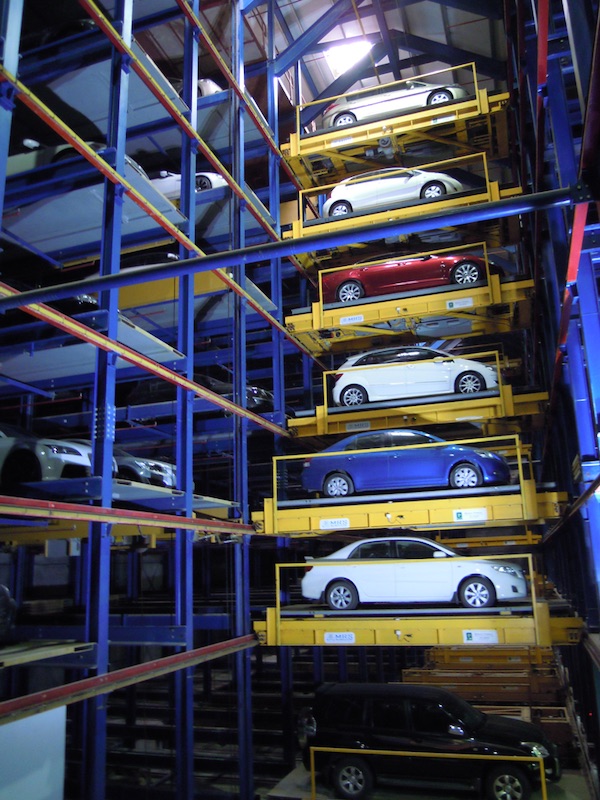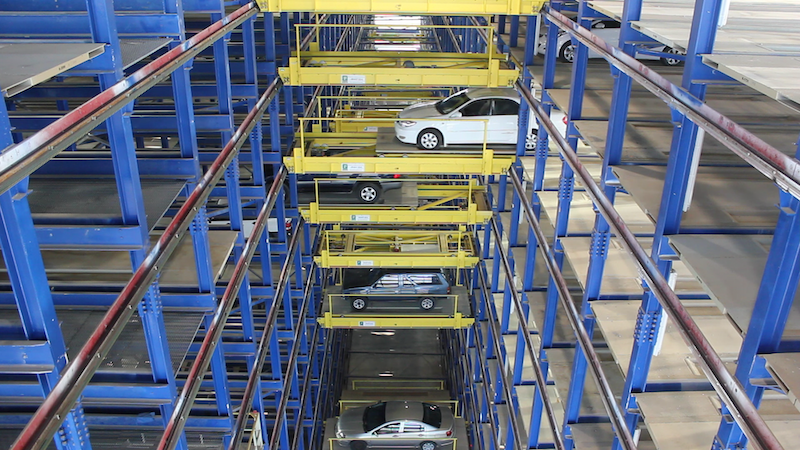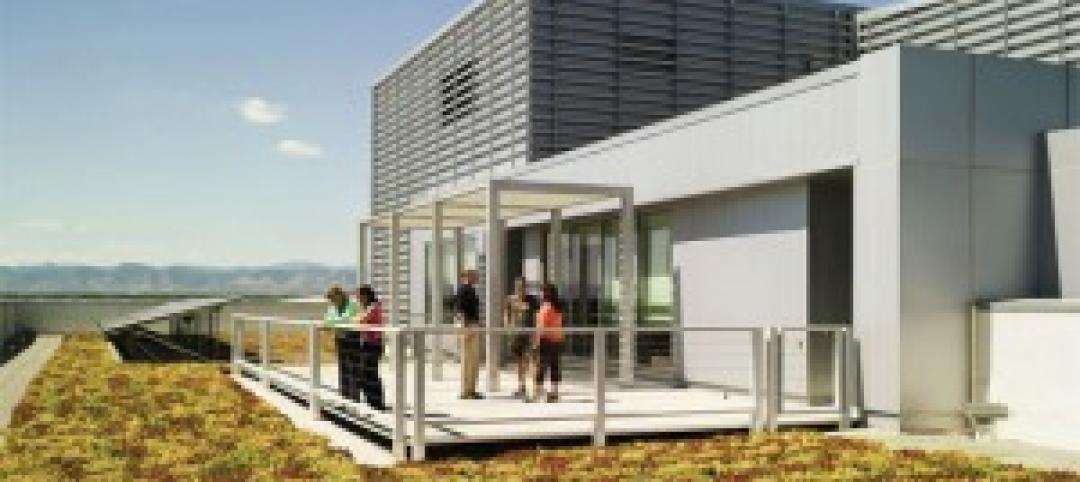Robotic Parking Systems (RPS), a Clearwater, Fla.-based provider of some of the largest and fastest high-density autonomous parking garages in the world, is poised to make a push into the U.S. market at a time when developers are rethinking just how much parking their buildings will actually require in the future.
RPS, which built the first autonomous garage in the United States in Hoboken, N.J., in 2001 (a garage that’s still operational to this day), has been focusing its attention in recent years on the Middle East. The company is preparing to release an online, AIA-approved education program that provides details for planning, installation, and operation of autonomous parking facilities.
While it did not give specifics about which markets it is targeting or its timeframe for domestic growth, RPS tells BD+C that it can now provide general contractors and architects with metrics that compare its system with other autonomous garages. “We are geared to bring this successful technology to the U.S.,” which could include partnerships through which RPS handles the parking aspect of a new construction project, the company states.
SEVERAL MIDDLE EASTERN PROJECTS PROVIDE PERFORMANCE RECORD FOR AUTONOMOUS GARAGES
Robotics Parking Systems touts a track record for its systems that, through design redundancy, it claims guarantees 99.99% uptime and a retrieval rate of over 400 vehicles per hour.
Also see: A New ULI Report Chronicles the Depaving of America
The company points specifically to projects in Dubai, UAE, and Kuwait with some of the largest automated parking garages, as measured by Guinness World Records. The latest record holder (as of 2018) is Al Jahra Court Complex, which was designed with a combination of 684 concrete ramp parking spaces with 2,314 automated spaces on top. RPS’s portion of this project provides almost 3.5 times the number of conventional ramp-style parking spaces in about the same cubic area. (The conventional space is seven levels and over 97 ft high; RPS’s portion is 11 levels and 115 ft high.)
This robotic parking system can deliver seven cars per minute, with an average retrieval time of 177 seconds. It has a peak traffic throughput of 425 cars per hour inbound/outbound.
RPS claims that what makes its system different from competitive automated systems is “advanced technology” whose unique design can independently move dozens of vehicles simultaneously on electro-mechanical robots on three axes (left-right, forward-back, and vertically).

RPS's “advanced techology” combines software, sensors, platforms, lifts, motors, and other mechanical gear to transport vehicles to open slots in the garage. Through electronic and mechanical redundancies, this system claims that it never needs to shut down, even during maintenance or repair.
As the vehicle owner drives into a street-level terminal, a combination of software controls, platforms, lifts, motors and sensors transports the vehicle to an available open slot in a multi-level shelf system. When the owner wants to leave, the system locates the vehicle and returns it to a ground-level exit terminal.
Also see: Gly Construction to build underground, robotic parking garage for Seattle Cancer Care Alliance
The parking system’s major electrical and mechanical components have at least one backup system, and in some cases as many as four. So, “if any machine goes down to be serviced, you still have full operation without interruption,” says Richard Scarth, MRICS, senior development manager for Seven Tides, a luxury property developer and holding company, whose Ibn Battuta Gate mixed-use complex in Dubai, UAE, has had an autonomous parking garage for 765 vehicles since it opened in 2009.
Scarth notes that because this building had a limited amount of land for parking, “the only we way could squeeze in the extra parking was to use high-density, autonomous parking technology.”
COST OF PARKING SYSTEMS DEPENDS ON CAPACITY

RPS claims that its system can increase a building's parking density by 200-300% within the same footprint as a conventional concrete-ramp garage.
When asked about costs for its autonomous system, RPS directed BD+C to the website roboticparking.com, which states that the cost of robotic parking facilities depends on three factors: the number of parking spaces, the amount of land, and peak traffic loads. So assuming a parking garage with 750 cars and peak traffic at about 30% of parking capacity, the total cost of robotic facility would be $24,567 per space, versus $26,433 per space for a concrete ramp garage with the same features such as electric vehicle charging stations, security, and wayfinding.
(This calculation is a bit skewed because it adds $2.25 million for a concrete ramp garage to include autonomous car driving capacity into and out of the garage.)
Also see: Do car-free downtown zones work? Oslo, Yes; Chicago, No
RPS also notes that its system typically is not conducive to retrofitting an existing garage.
A bigger question for RPS and its competitors is what future demand for parking garages will look like. Ride sharing has been changing the way Americans view their relationships with automobiles. And cities like New York and San Francisco have converted streets and entire blocks to pedestrian-only thoroughfares.
As more metros commit to reducing their carbon emissions over the next 10 to 30 years, those plans invariably include reducing vehicular traffic in favor of other modes of transportation that are environmentally palatable. Indeed, some architectural firms have already come up with designs for adapting parking garages into something else—like multifamily housing or offices—if reduced demand warrants such reuse.
Related Stories
| Nov 18, 2011
Centre for Interactive Research on Sustainability opens
Designed to exceed LEED Platinum, the Centre for Interactive Research on Sustainability (CIRS) is one of the most innovative and high performance buildings in North America today, demonstrating leading-edge green building design products, technologies, and systems.
| Nov 17, 2011
Campus-wide energy-efficiency program aims to deliver $3.5 million in energy and operational savings
Merced College and Honeywell will use the school’s energy usage statistics to develop a course curriculum on sustainability, and raise awareness among students of the positive impact conservation practices contribute to the community.
| Nov 16, 2011
Project completion of BRAC 132, Office of the Chief Army Reserve Building, Ft. Belvoir, Va.
This fast-tracked, design-build project consists of a three-story, 88,470 sf administrative command building housing approximately 430 employees.
| Nov 15, 2011
Miller joins Perkins Eastman as regional manager, Middle East and Northern Africa
Miller joins Perkins Eastman with more than 48 years of experience in architecture, design management, and construction administration for planning and infrastructure.
| Nov 11, 2011
How Your Firm Can Win Federal + Military Projects
The civilian and military branches of the federal government are looking for innovative, smart-thinking AEC firms to design and construct their capital projects. Our sources give you the inside story.
| Oct 25, 2011
Commitment to green building practices pays off
The study, conducted by the Pacific Northwest National Laboratory, built on a good indication of the potential for increased productivity and performance pilot research completed two years ago, with similarly impressive results.
| Oct 18, 2011
Dow Building Solutions invests in two research facilities to deliver data to building and construction industry
State-of-the-art monitoring system allows researchers to collect, analyze and process the performance of wall systems.
| Oct 17, 2011
USGBC L.A. Chapter's Green Gala to feature Jason McLennan as keynote speaker
Chapter to presents inaugural Sustainable Innovation Awards,
| Oct 17, 2011
Schneider Electric introduces UL924 emergency lighting control devices
The emergency lighting control devices require fewer maintenance costs and testing requirements than backup batteries because they comply with the UL924 standard, reducing installation time.
| Oct 14, 2011
AISC develops new interoperability strategy to move construction industry forward
AISC is working to bring that vision to reality by developing a three-step interoperability strategy to evaluate data exchanges and integrate structural steel information into buildingSMART's Industry Foundation Classes.

















